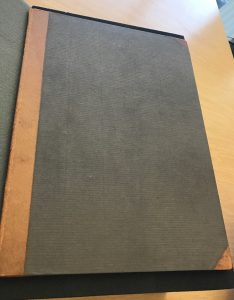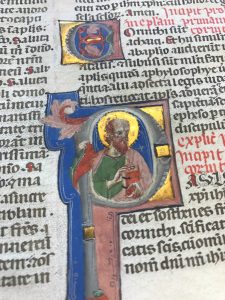 Taking a break from the Plaskitt Bible, the other “bible” that I chose to work on is not a complete bible at all. It is only I Corinthians and II Corinthians that were taken out of the original binding and rebound together. When you first see it, it is underwhelming. It is a thin, plain light brown book that isn’t even faintly reminiscent of what the typical idea of a bible is. Why has this book been taken apart and rebound? Is there any special meaning to the parts of the bible that were chosen? Instead of just binding together the parts of Corinthians separately and creating 2 books to sell for a profit, why did they choose to keep them together?
Taking a break from the Plaskitt Bible, the other “bible” that I chose to work on is not a complete bible at all. It is only I Corinthians and II Corinthians that were taken out of the original binding and rebound together. When you first see it, it is underwhelming. It is a thin, plain light brown book that isn’t even faintly reminiscent of what the typical idea of a bible is. Why has this book been taken apart and rebound? Is there any special meaning to the parts of the bible that were chosen? Instead of just binding together the parts of Corinthians separately and creating 2 books to sell for a profit, why did they choose to keep them together?
Although the outside is plain, what is inside is really what matters. Everyone knows the saying don’t judge a book by its cover, and that saying is especially true with this book. What is so special about this bible in the collection in particular is that it is made of parchment instead of paper. For anyone reading this blog post that doesn’t know what parchment is, it is a thin material used for writing that is made from the skin of an animal that was treated and stretched thin. On the parchment on the interior of the book, it is written in Latin and there are historiated initials that are colored and have gold accents. There are also red and blue swirls that cascade down the page. This shows that this bible was originally made for someone who had a lot of money that could afford to have the initials lavishly decorated. 
On the inside of the book in the upper left corner, it says “15th cent.”. This is probably to identify the period that this is from because without any of the original binding or other information it would be difficult to identify the time that this was from. This is interesting because the 15th century would have been the time in which the printing press was being used to create bibles. Was this bible originally made in the 15th century or was the 15th century when it was cut out from the rest of the bible that it could have been a part of? There is no way to easily identify anything about the history of this book without the use of the note card that is tucked inside between the cover of the book and the first flyleaf. This notecard identifies this as belonging to Reverend Monsignor John Fletcher, of Malden, Massachusetts. Was this book gifted to Reverend Monsignor John Fletcher or was it passed down through the church and eventually came to him?
When trying to research the reverend, I had a lot of trouble trying to find information about him. I found a collection of books called The Works of the Reverend John Fletcher (6 vols.) and I was excited that I found something from him that was important. After some more research, I found out that this is probably not the same John Fletcher. This leads me to believe that despite his title of Monsignor, an honorary title usually given by a pope, he did not leave a lasting effect, despite how influential he may have been at the time. I will continue my search for information on John Fletcher and hopefully be able to report more in later posts.